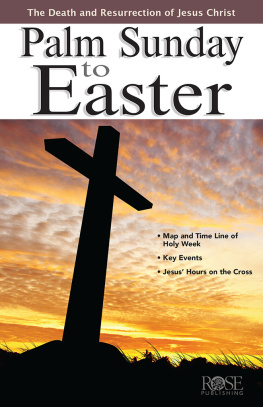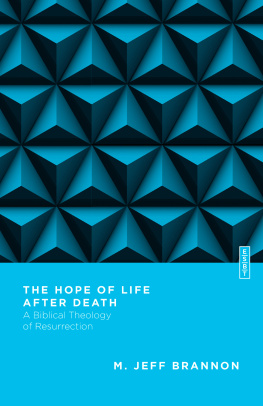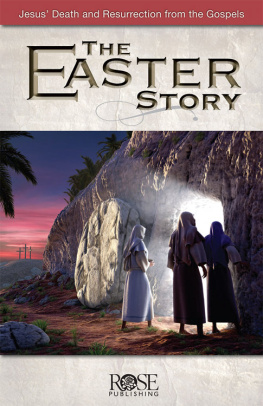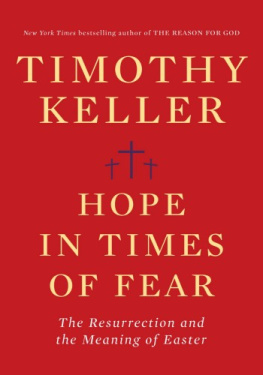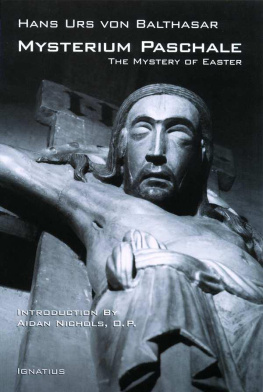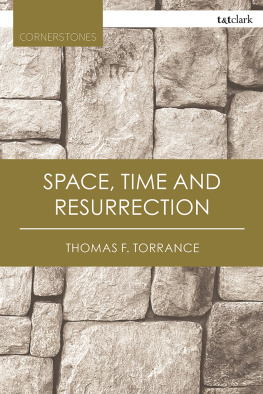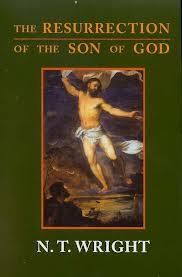Copyright Paula Gooder 2012. All rights reserved. Except for brief quotations in critical articles or reviews, no part of this book may be reproduced in any manner without prior written permission from the publisher. Visit http://www.augsburgfortress.org/copyrights/ or write to Permissions, Augsburg Fortress, Box 1209, Minneapolis, MN 55440.
Scripture quotations are from the New Revised Standard Version of the Bible, copyright 1989 by the Division of Christian Education of the National Council of the Churches of Christ in the USA. Used by permission. All rights reserved.
The paper used in this publication meets the minimum requirements of American National Standard for Information Sciences Permanence of Paper for Printed Library Materials, ANSI Z329.48-1984.
Manufactured in the U.S.
This book was produced using PressBooks.com.
This book is in some ways self-indulgent. Easter is one of my favourite times of the year and resurrection one of the pillars of my faith. Yet many years I find myself disappointed. We work our way through Lent, reflecting deeply on issues of life and faith and, at last, arrive at Easter Day, when so often we stop our study and carry on as before. Many people read Lent books, some of which explore Jesus journey to the cross but then stop just before the resurrection or, occasionally, mention the resurrection in their last chapter. I have for many years longed for a book that would take me on a journey through Easter to Ascension Day and Pentecost, which would allow me to think more deeply and seriously about what the resurrection means to me and the way in which I live my life. (Such a book might also allow me to rectify the fact that I never did quite finish that Lent book I began six weeks ago!)
In the end, I decided that the only thing to do was to write my own Easter book, which could accompany me on a journey through the stories and ideas about resurrection we encounter in the Bible, and to ask what living a resurrection life might mean. So this book is largely self-indulgent, but I hope not entirely so. If you, like me, have wanted to travel more deeply into what Jesus rising from the dead really means, then I hope this book might be a helpful companion on your journey.
One of the challenges of writing an Easter book is how to apportion the chapters. Should Marks Gospel get more or less space than Matthews Gospel? How much room should Paul get? In the end, I decided to choose 42 passages which, if you opt to read this book between Easter and Pentecost, will give you six a week for seven weeks (one a day with one day off per week). You may of course not choose to read the book after Easter, or not solely after Easter, or not as a book of daily readings, and in that case you can decide for yourself what to read when.
You might like, before you begin, to decide how you want to go about considering the resurrection. One option is to follow the order I have put down (the resurrection in the Gospels, Paul, other Epistles, then the ascension, then Pentecost); another is to mix up the readings a bit more. If, for example, you know that you find the writings of Paul hard or, indeed, that you have a preference either for Pauls theology or the narratives of the Gospels, you might like to intersperse your readings from the Gospels with those from Paul. In this way you can reflect on the two side by side, which can be an interesting and helpful thing to do.
Most sections begin with a short passage from the New Testament which forms the basis of my reflection, with a suggestion for a longer passage, if you would like to read further. Occasionally there is only the short passage because the longer context has been explored in either the previous or the subsequent section (or both).
On putting things in and leaving things out
One of the greatest challenges of writing a book like this is not so much what to put in as what to leave out. I had covered most (though not all) of the Gospel narratives about resurrection but then faced the challenge of how to select passages from Paul, Acts and the rest of the New Testament for the sections on the resurrection in the Epistles, the ascension and Pentecost. In the end I chose what I think are the most important passages then halved them, then shaved off a few more, until I was left with the ones included in this book. If I wrote this book again I might make different choices (and no doubt many of you would have chosen different passages as well) and so I offer this selection as a snapshot of what I thought were helpful passages at the time of writing.
In a similar vein, there is much, much more to say about the passages than I have said here. In the end I restricted myself to one major focus (with a few exceptions) per passage. This will inevitably mean that I have missed some crucially important points and maybe included others that you might not have put in. I did this consciously because my aim in writing this book is to produce a series of reflections that are more suggestive than conclusive, more thought-provoking than exhaustive. I dont want to have the last word (or anything approaching the last word) but to frame some initial thoughts that might help you find your own words about the resurrection and our life in Christ.
The alert reader will notice that I havent anywhere discussed the question of the historicity of the resurrection. The reason for this is very simple I dont think its the most important question to ask. This may sound surprising and I dont intend it to be. What I mean is that in the latter half of the twentieth century this was one of the few questions ever asked about the resurrection. The result was an almost impossible stand-off between those who said yes, it was historical, and those who said it wasnt, which, over time, led to a discomfort with talking about the resurrection at all. There is very little that can be added to the debate about historicity. The resurrection cannot be proved to be historical, but it would also be hard to disprove it. What we can do, however, is to ask what it meant to the earliest Christians and also what it might mean to us today. This is the major focus of my reflections in this book. If you wish to reflect further on questions of historicity, then you will need to look elsewhere and after the introduction I have made suggestions of a few books for further reading that might help you if you are interested in this area.
In a similar vein, I have also opted to take belief about the end times at face value. Although many Christians today prefer not to talk about the end of the world, perhaps because it seems so distant and unlikely, the New Testament writers were adamant in their belief that it would happen. We can only really understand resurrection if we also assume a belief in the end times. Remove the end of the world and much New Testament theology becomes illogical. Whatever your own beliefs on the subject, we have to take a step into the New Testament writers world in order to comprehend what they were talking about. Part of that world was believing in the end times, and we need to assume this outlook if we wish to talk about how the New Testament writers understood the resurrection.


